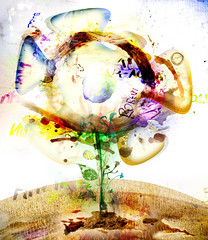I dislike most swimming pools, not because of the chlorine, but simply because they’re cold. Maybe it’s a mind-over-matter thing, or maybe it’s the diameter of my arteries: but when I step into a pool, a low "degrees Fahrenheit" translates into high degrees of blue and purple numbness. In testing out the waters of teaching this past semester, the art classroom thermostat also fluctuated. Often it was satisfying and warm (like a well-tuned, cascading showerhead); occasionally it was arctic and frigid. And now, as summer envelopes me, I resolve to express something of what I’ve learned in these experiences.
Weather-men animate for us maps of warm and cool colours, indicating pulsating rhythms like the temperatures of the ocean. Human beings, likewise, oscillate and writhe between modes of surviving and thriving. Survival, according to my colleagues, is apparently the primary goal of one’s first year in teaching. Well, I never bought that argument, and I still don’t. In fact, I’ve probably taken survival for granted, resting on a kind of over-confidence that I’ve gathered in growing up at a table where teacher-won bread was eaten. But the survivalists do speak grains of truth. The fresh brand of humility that is learned in working with loud, disrespectful, wonderful teenagers is unique to the field. Where else, but in art education can one repeatedly scrape dried paint out of a sink, asking "why?"? I supposed that in such instants of agony, teaching does momentarily become a mere survival exercise. In the long term, however, the joys of artistic engagement, of constructive criticism, of patience, and of living out an applied colour theory, remain catalysts for a thriving informed by the exuberance of creative youth.
The often-caricatured experience of the teacher as Daniel – surviving in the face of lions – offends me because it portrays students as beasts: in fact they are delightfully human. The encounter between teacher and teenager is of course incredibly intense. It is a long-term covenant in which a vast amount of potential is at stake, and which demands from all parties a bottomless supply of enthusiasm. When there have been failings, they really, really hurt. But in my better moments at ECHS, I think, the learning has been mutual. So here’s to teenagers: energetic, zestful individuals, thriving on overdoses of confidence and scepticism, their capacities for love (and hate) fuelled ever onward by their humanity.
Humanity can only be fully realized when (in Christ) we are forgiven, and (like Christ) forgive. In this latest digital painting, I want to touch on just that sort of redemption. In his refraction 31, Makoto Fujimura quotes Lewis Hyde, who tells us that the artwork is "a gift, not a commodity." I concur, realising that the gift economy must necessarily be also a forgiven economy. And so I want to forgive my students and colleagues for their excesses, and to be forgiven for my own. I want this flourishing flora to drink deeply from the pool of sustaining nutrients: faith, patience, forgiveness, endurance…. hope. These things, of course, are scarce, but it seems to me that God gives us just enough. We plant things that lose their petals to the wind, but in these flickering, broken acts of worship our Creator is glorified.
In this piece, I employ the visual language of art materials at ECHS. It is an aesthetic rooted in Fergus’ agricultural tradition, sprouting with the leaves of dry-erase markers and oil-based paint, blossoming through digital vector curves and the splattering of left-on-the-counter watercolours. Names, scrawled on mylar papermaking surfaces, have (among onion skins and clay) become organic petals. And here is the redemptive point: that even in the messes we’ve made, God finds beauty. So go, pick up the pieces of your mistakes, and make something out of it: for the lot of them, you’ve been forgiven anyway.
